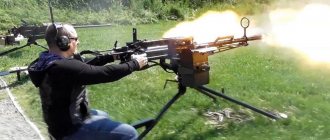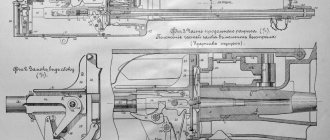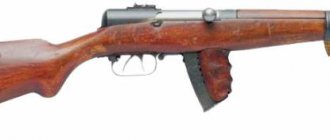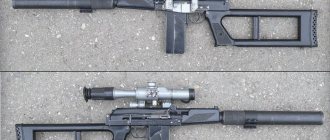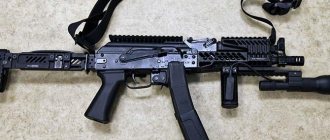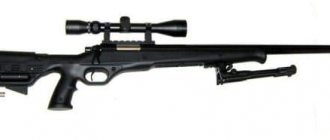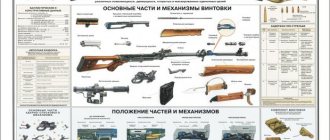Photo: Tula State Weapon Museum
June 14 marks the 150th anniversary of the birth of the legendary designer Fyodor Vasilyevich Tokarev. During his long life, he managed to become famous in Tsarist Russia and become one of the main gunsmiths of the USSR. The list of his inventions includes a TT pistol, an SVT automatic rifle, an MT machine gun and other weapons. We remember the firearms masterpieces of the legendary designer.
MT machine gun: manual "Maxim" for Soviet soldiers
Weight in firing position – 15.5 kg Combat rate of fire – 600 rounds/min Magazine capacity – machine gun belt for 100 or 250 rounds Sighting range – 2000 m
F.V. Tokarev with his son Nikolai at a light machine gun of the Maxim-Tokarev system of the 1925 model, in the first room of the design bureau of the Tula arms plant, 1925.
In 1921, Fyodor Tokarev moved to Tula and began his long career at the Tula Arms Factory. It is here that he creates his best designs. It all started with work on a light machine gun based on the Maxim machine gun. At that time, its production had been mastered by the plant, so it was necessary to cope with the task by making minimal changes to the production process. Fyodor Vasilyevich succeeded, and already in 1925 the first domestic light machine gun MT (Maxim-Tokarev) was put into service.
While maintaining its reliability and reliability, Maxim received one very important advantage - maneuverability. The British Maxim machine gun was good as an easel machine gun, but its weight of 90 kg made it clumsy. The “difficult” position of the machine gun was slightly corrected by the new Sokolov machine gun, which was put into service in 1910. It made it possible to roll a machine gun even with the help of one person, but in practice, dragging the machine and machine gun along difficult roads was still a difficult task.
Tokarev managed to replace the cooling with air, and also get rid of the heavy machine. Instead, the Maxim was placed on a bipod, and the machine gun now had a wooden stock and trigger. The manual MT had a length of 1330 mm and weighed only 12.9 kg. This design gave the machine gunner more freedom: he could do without outside help when changing his firing position, and it became much more convenient to shoot.
Like the easel prototype, the manual Maxim fired 600 rounds per minute. To store and supply ammunition of 7.62x54 R caliber, belts with 100 or 250 rounds were used.
Operating principle
To simplify the manufacturing process of the MT machine gun as much as possible, the main developers of the MT project completely copied the automatic charging system from the basic version of the legendary MAXIM. A completely new model of weapon had a movable barrel with the shortest possible stroke. The barrel locking system was operated by special two levers. The machine gun belt approached from the right side of the original receiver. During the firing process, the automatic system captured the cartridge and escorted it to the line, which sent it into a special chamber. The spent cartridge case jumped out of a special window, which was located at the bottom of the original receiver.
TT pistol: a weapon legend of World War II
Weight in firing position – 910 g Combat rate of fire – up to 34 rounds/min Magazine capacity – 8 rounds Sighting range – 25 m
“Combat” is a famous photograph from the Great Patriotic War, taken by Soviet photographer Max Alpert. The photograph shows a commander rousing soldiers to attack with a TT pistol in his hand.
The TT pistol (“Tula Tokarev”) was created in 1929, and put into service in 1931. Tokarev's development won the competition for a new army pistol, which was supposed to replace the outdated Nagan. Thus, the TT became the first self-loading personal weapon of Soviet officers.
The Tokarev pistol had a good range - the target could be accurately hit at a distance of up to 80 meters. At the same time, the main advantage of the TT was its firepower. The famous gunsmith John Moses Browning said about the Tokarev pistol: “No other person in the world has managed to concentrate so much deadly force in such a small piece of metal!”
The TT became one of the best pistols of World War II. Mass production of the pistol began in 1933 at the Tula Arms Factory, and by the beginning of the war it exceeded 100 thousand units per year. Production of TTs did not stop at the Tula plant even when enemy troops stood at the city walls. In total, until 1953, more than 1.7 million TT pistols were produced.
Application
The first samples of improved machine guns were put into service in mid-1925. This improvement significantly strengthened the combat power of the ranks of the Russian army. Long-term use revealed the main disadvantages of this machine gun.
The reduced weight of the MAXIMA-TOKAREV machine gun not only made it easier to use the weapon, but also made it particularly uncomfortable when carrying out regular maintenance of the model. The shortcomings affected the operation of the automation, the cartridge supply system and some delays during prolonged shooting.
Such negative characteristics required speedy improvement, which was carried out throughout 1926. Correcting all the problems and negative aspects in the operation of the MT machine gun, the industry mastered the mass production of this weapon. Supplies to the Russian army continued throughout 1926. After lengthy modifications to the machine gun, it was clearly decided to abandon this weapon for the needs of the army.
One of the most influential reasons that motivated the abandonment of the MT machine gun was the creation of a new machine gun by gunsmith V.A. Degtyarev called DP-27. This model completely replaced all the original MT machine guns, as it had more advanced characteristics that did not require modifications.
The MT machine gun was produced until the fall of 1926. Over the years of production of the original model of light machine guns, more than 2,500 units of this weapon were supplied to the Russian army. All unused models of the MT machine gun were sent to warehouse storage. In 1938, the original machine guns were first used in military operations that took place in Spain as part of the Civil War.
And in 1940, a certain number of units were sent to China. The total number of weapons is unknown. Chinese museums still have examples of MT machine guns. Despite a large number of failures and shortcomings, the MAXIMA-TOKAREV machine gun is the first domestically developed light machine gun that was mass-produced.
Rifle SVT-40: combat "Svetka"
Weight in firing position – 4.51 kg Combat rate of fire – 25 rounds/min Magazine capacity – 10 rounds Sighting range – 1500 m
People's militia fighters, scouts P. Vanyushev (left) and G. Golovach examine the village of N. during the battle for Moscow. The fighters are armed with self-loading Tokarev rifles of the 1940 model (SVT-40). Photo: Peter Bernstein / waralbum.ru
In May 1938, the country's military leadership announced a competition for the best self-loading automatic rifle. Samples from several designers reached field testing in 1939. The rifle of Fedor Tokarev was recognized as the best, which almost immediately received a baptism of fire in the Soviet-Finnish war.
Based on the results of its use in real combat, Tokarev modified the rifle, and after that it was put into service under the name SVT-40. Firstly, the weight of the rifle was reduced to 4.3 kg, the bayonet became less bulky, and the parts became more reliable in contact with dust and dirt. This work brought Fedor Tokarev the Stalin Prize; the designer was also awarded the title of Hero of Socialist Labor and the degree of Doctor of Technical Sciences.
Production of the new rifle began on the eve of the war, and the SVT-40, or “Svetka” as the soldiers called it, became the main automatic weapon of the Red Army. Production was launched at the Tula Arms Plant, where SVT-40s replaced Mosin rifles. Later, the Izhevsk Arms Plant also began to produce the rifle.
Almost immediately, a sniper version of the rifle appeared in service with the Soviet army, which was equipped with a bracket for an optical sight and was distinguished by better processing of the barrel bore. In total, about 50 thousand SVT-40 sniper versions were produced. Legendary Soviet snipers fought with them, including the famous Lyudmila Pavlichenko. The Tokarev rifle was also valued on the other side of the front - it is known that the Germans were happy to arm themselves with captured SVT-40s.
History of this sample
In the 20s of the last century, one of the most important issues facing the country's leadership was the correct choice of direction for the development of automatic weapons for the needs of the infantry. At that time, the production of various types of light machine guns, which had excellent performance characteristics, became increasingly popular.
In 1924, a task was set, which was to develop a new type of light machine gun for the needs of the Russian army. To resolve this issue as quickly as possible, it was decided to create a new type of weapon using the existing developments of existing models. The most optimal option for the production of a new machine gun was the original HIRAM MAXIM heavy machine gun, which had an excellent reputation over many years of operation.
Workhorse of the infantry
The history of the Russian “Maxim” began, but initially machine guns were purchased for the Russian army in a heavy and very bulky version. On a full-size machine, with large wheels, a frame and a shield, they resembled a cannon. Machine guns came into service with the Russian army, navy and serf units, largely at the suggestion of Emperor Alexander III, who was personally familiar with the machine gun. These were English-style machine guns, which were initially adapted to the Russian Berdan cartridge. Only with the adoption of the Mosin rifle did the machine gun adopt its unchanged caliber 7.62x54. Until 1910, massive machines were used, which, however, during the Russo-Japanese War were often replaced with handicraft, but lighter ones, the options of which depended only on the creative abilities of the calculations that made them. "Maskim" showed its strength in the battles near Mukden and during the defense of Port Arthur. The command realized that they had the latest and most formidable weapons in their hands.
Our machine gunners during the Russo-Japanese War
In 1910, the second stage of the evolution of the Russian “Maxim” began. It is associated primarily with the name of Colonel A.A. Sokolov, who invented the already familiar wheeled machine gun for the machine gun, which received the name of the developer, and a slightly curved shield. So “Maxim” took on its “established” appearance. Its distinctive feature was a roller for feeding the tape, attached to the shield or to the body, new sights, a redesigned casing and new boxes for a 250-round fabric belt. The machine gun on Sokolov’s machine became more maneuverable; two people could move it across the battlefield, and when fully loaded and with water in the casing, it weighed only 70 kg.
The legendary cart armed with Maxim
In this form, “Maxim” went through the First World War and the Civil War. In the harsh conditions of front-line operation, the Maxim received excellent reviews from the soldiers who used it. Reliability, exceeding the standard one, sometimes doubled, and with proper care, simplicity and reliability made this machine gun (by the way, the only one produced in Russia) a legend of the domestic arms industry. The stable machine and the shield covering the crew made it possible to suppress with fire and literally mow down advancing enemy infantry lines. Maxims were installed on both armored cars and armored trains. Unfortunately, it was not possible to ensure sufficient quantitative production of machine guns during the First World War; other parties to the conflict (Germany with the MG-08 or Britain with the Vickers) produced much more machine guns.
There were also attempts to lighten the machine gun, like this one, which did not go into series MT (Maxim-Tokarev)
The Civil War gave the machine gun an aura of daring and later fame on movie screens, where the Maxim was often placed in the legendary cart for mobility - so popular in parts of the Red Army and among the Makhnovists.

